There are three main components to a successful deer stalk: patience, precision and the ability to remain quiet whilst in hideously uncomfortable surroundings. What put me off having a go with a rifle is that I am famously- seriously ask anyone that knows me- impatient, erratic and incapable of sitting still/being quiet for more than 5 minutes at a time. The immense challenge was undertaken by Steve Rawsthorne, one of the rifle specialists at Holland and Holland, to guide me through the Deer Stalking Course offered at the shooting grounds- taking me from zero to hero on the range.
Despite my recent endeavour into the world of shooting- you might recall I took part in Holland and Holland’s green feather course- I have never before shot a rifle. Gulp. I was assured that my lack of experience was not a bad thing; I wouldn’t have picked up any bad habits needing to be urgently rectified. Still, as I glanced over the information pack provided with the course I couldn’t help but feel dubious about my chances of success.
Before leaving the pavilion I was provided with all safety equipment and taught the correct way to carry and handle the rifle either loaded or unloaded. Then it was off to the range, I had everything to learn and a deadline of only three hours.
For those who aren’t familiar with the course, it consists of three hours instruction, including ammo, culminating in a proficiency test and multiple choice quiz. You can take the hours separately (although it is advised if you wish to split the course to take the first two hours together) or all at once. I decided upon the latter, hoping that my eyes and attention span would last the duration.

We started at the 50 yards station on the range where we went through the first section. We talked about all elements of safety; Steve demonstrated using the rifle, explaining everything I needed to know to be competent. Proof marks and the fallout range of a bullet (a centrefire round will travel up to 4k uninterrupted!) were just a few of the things discussed, only signed off for once I had fully grasped the concept and importance of each point. Once the information was imparted we moved on, but I was asked to reiterate what I had learnt throughout the three hours.
At different stages in my lesson and under varying levels of stress, for example, after rushing a shot and blowing a perfect 5 on target- ARGH- I was asked to make a decision as to whether or not a shot was safe to take. Full-size silhouettes of deer can be found strategically placed around the field, some partially hidden or on the brow of a hill and others fully visible and in front of grass banks. Visualising the deer put into context how careful you must be when out stalking, and I know now how serious the stakes are when deciding to take a shot.
After Steve was satisfied with my safety and basic understanding of the rifle, I got to practice with a .22. Much to my shock I hit the target every time, one even in the centre. So great was my surprise I made Steve sign the target for me to keep, nobody would have believed me otherwise. With a little confidence we progressed on to section two.
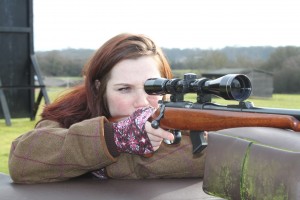
In the second section I learned all about the rifle itself, its mechanics and the ammunition used. I was introduced to technical terms like ‘grain weight’ and ‘click’ and learnt how to zero it before starting to shoot. The .243 looked much bigger and much scarier compared to the .22. I was concerned about the recoil and noise; not such a ridiculous fear when you can hear the rifles at the range from inside the clubhouse! Steve reassured me and offered to demonstrate what I would be doing, how to triangulate and then line up a shot with my face in the right position on the comb. I was surprised to learn that breathing is as important with rifle shooting as it is with yoga! Seeing him take a shot first, talking through the process and letting me see the results helped with my initial reservations, and I was keen to have a go myself.
Then came the real shooting! I practiced standing off sticks (my favourite) sitting in the high seat, prone with bi-pod and even kneeling (my absolute least favourite.) I was hooked. What’s so satisfying about shooting a rifle is that you can see the results for longer than it takes for a clay to disappear in a puff of smoke. Taking the target down to see that four or five rounds made their way neatly through the centre is a huge confidence boost, and the most encouragement you could get when learning.
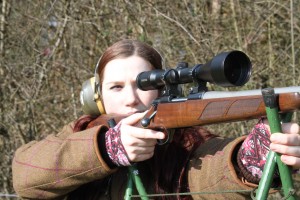
The practice all gears you towards the shooting test, making sure that you are safe and adept enough to shoot a rifle off site. To pass, you need to take 11 shots on aim across two different targets. The first is similar if not the same as the target you practice with- it’s not so distracting trying to put 5 bullets into a target when you’ve done it several times before. The second target is a life size silhouette of a deer with a circle depicting the ‘kill zone,’ the area of which a shot will humanely do its job. It took me two attempts to complete the first target. I rushed a shot right at the end, jeopardising my previous 4 and having to retake them all. I am proud to say, though, that I breezed through all shots after that with time to spare at the end.
Steve was a fantastic coach throughout, giving me tips, tricks and pointers to make my life easier (and safer) when out shooting with a rifle. He was incredibly patient and encouraging and his relaxed attitude made me feel comfortable with the firearm from the beginning. The course allows plenty of time to build up to the test both theoretically and practically so you don’t feel rushed or under any pressure. I couldn’t believe h
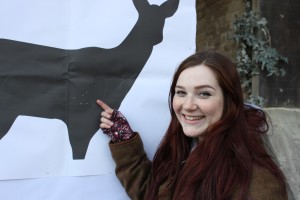
ow quickly the time had gone but after just over two hours, it was time to undertake section three, and my multiple choice test.
Before completing the quiz, Steve talked me through the rest of the pack. Along with all completed sections signed off by your instructor you’re given additional information to take home as a reference for what you’ve learnt. Deer stalking codes of practice and BASC membership are just a few of the topics covered as well as in depth information about identifying deer, their seasons and the legalities of shooting them. If you’re applying for a firearms certificate/licence the pack provides a fantastic reference point for the officer assessing your application.
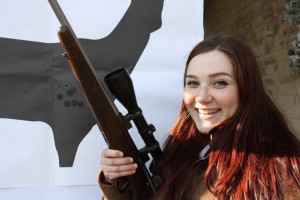
I won’t ruin it for you should you decide to take the course, but the multiple choice test is not something to be too concerned about. Everything you learn throughout the three hours is so ingrained by the time you’ve finished; it’s hard to believe you didn’t know it all before. You’re given a healthy forty five minutes to complete the quiz but I’d be surprised if you needed any more than thirty. After completing the final section I was handed my certificate and information pack and let loose on the coffee pot which went a a long way to defrost my frozen nose.
Before the course I had no idea about numbers of deer or the reasons they needed to be culled. I always struggled with the idea of stalking, thinking it to be an unnecessary practice, perhaps even cruel; I mean, we’ve all seen Bambi. What I’ve learnt, though, is that Britain has some of the healthiest herds in the world, relatively undisturbed by disease and overpopulation, and this comes down to the steady cull of deer- the money from which goes back into their conservation. That’s not to say I’m ready to grab some camo waterproofs and head out just yet, I have a way to go, but I’ve come to understand and appreciate the importance of the issue.
What makes the course so enjoyable is the balance of practical and theoretical knowledge imparted. There’s a lot to get your head around, especially starting off with no experience, but the course is cleverly designed to immerse you gently and completely- you’re never overwhelmed with too much information at any one time and the practical elements break the theory up nicely.
Until next time!



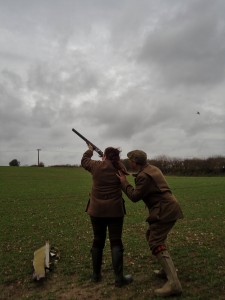 n Saturday morning nervous, incredibly nervous, and I couldn’t shake the butterflies. Apprehension is the wrong word, what I felt was more a concern that I
n Saturday morning nervous, incredibly nervous, and I couldn’t shake the butterflies. Apprehension is the wrong word, what I felt was more a concern that I
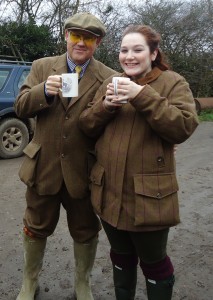 tually hit something. On discovering it was my first pheasant I was ‘blooded,’ initiated properly into the fold, and although slightly grossed out I was extremely proud.
tually hit something. On discovering it was my first pheasant I was ‘blooded,’ initiated properly into the fold, and although slightly grossed out I was extremely proud. As the drives went on the wind became progressively worse. For a group consisting of relative novices I’d say we did fantastically well. The wind got up to 40 miles per hour at times which made the birds incredibly fast and unpredictable in flight. Most of us had practiced shots loading for us, and everyone commented on how difficult the day would have been even for a more experienced gun.
As the drives went on the wind became progressively worse. For a group consisting of relative novices I’d say we did fantastically well. The wind got up to 40 miles per hour at times which made the birds incredibly fast and unpredictable in flight. Most of us had practiced shots loading for us, and everyone commented on how difficult the day would have been even for a more experienced gun.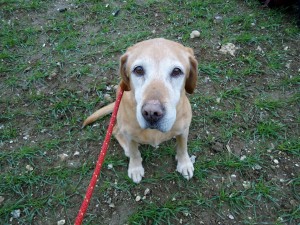 immerses you into a world that you might never have had a chance to experience otherwise, and all of that with a group of like-minded ladies.
immerses you into a world that you might never have had a chance to experience otherwise, and all of that with a group of like-minded ladies. ious stands paled in comparison to Jacksons Hole, a trap that spits clays out so high and at such a rapid pace it’s hard to even see one emerging
ious stands paled in comparison to Jacksons Hole, a trap that spits clays out so high and at such a rapid pace it’s hard to even see one emerging
 in the field. I practiced everything; from taking the gun out of the slip safely (which I’m assured I will become less cack handed at the more I practice) to mounting it out of shoulder whilst waiting for a drive.
in the field. I practiced everything; from taking the gun out of the slip safely (which I’m assured I will become less cack handed at the more I practice) to mounting it out of shoulder whilst waiting for a drive.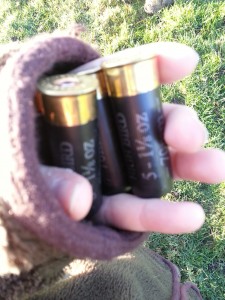 as quickly become my nemesis, a sentiment I seem to share with most guns, novice or otherwise. I tried to convince Clive that I should start with the gun in place- it being a different stand and me being relatively new to the whole process- but he was having none of it. You could sum up the whole ordeal with the concise ‘you tickled its tail feathers,’ a phrase I’m determined to hear as little as possible in my coming lessons. My bruised ego was comforted by the knowledge that Clive was happy with my movement of the gun, getting there quicker will come in time (hopefully).
as quickly become my nemesis, a sentiment I seem to share with most guns, novice or otherwise. I tried to convince Clive that I should start with the gun in place- it being a different stand and me being relatively new to the whole process- but he was having none of it. You could sum up the whole ordeal with the concise ‘you tickled its tail feathers,’ a phrase I’m determined to hear as little as possible in my coming lessons. My bruised ego was comforted by the knowledge that Clive was happy with my movement of the gun, getting there quicker will come in time (hopefully).